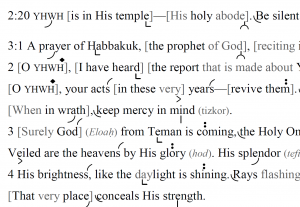DOWNLOAD:
PDF | ODT (sans Hebrew)
PDF | ODT (with Hebrew)
This is an English translation of the Haftarah reading for the Second Day of Shavuot (Ḥabaquq 2:20-3:19), transtropilated. (Transtropilation is the term coined by Len Fellman to describe the process of translating from cantillated Hebrew, as closely as possible, “word for word and trōp for trōp”, with the main purpose being to aid a person with minimal Hebrew training in following the Hebrew leyning word for word.) This translation is based on the following translations: Aryeh Kaplan’s The Living Torah (also my source for proper names & transliterations), Richard Elliott Friedman’s The Bible With Sources Revealed, Everett Fox’s The Five Books of Moses, The Stone Edition Tanach, The JPS Tanakh (Hebrew-English 2nd Ed. 2000) along with Orlinsky’s Notes on the New Translation of the Torah, The Jerusalem Bible (1966, also my source for topic headings), The New King James Bible; occasionally, esp. for Haftarot: The Torah—A Modern Commentary by Plaut et al; for Megillot, I also use H.L. Ginsberg’s The Five Megillot and Jonah.
Source

Recordings

“💬 Haftarah Reading for the Second Day of Shavuot (Ḥabaquq 2:20-3:19): Chantable English translation with trōp, by Len Fellman” is shared through the Open Siddur Project with a Creative Commons Attribution-ShareAlike 4.0 International copyleft license.










Leave a Reply